Finding the right product is no longer a matter of chance. In 2025, Amazon’s marketplace is defined by changing consumer behavior, rising advertising costs, and smarter algorithms that reward relevance and performance. What worked a few years ago can now limit growth or reduce profit margins.
Successful sellers today focus on precision and data-backed decisions. They study keyword trends, conversion rates, and competitor pricing before investing in new inventory. Whether you are launching your first product or scaling an existing brand, the gap between an average listing and a consistent bestseller depends on how well you understand both customer demand and Amazon’s A10 algorithm.
This guide explains how to identify profitable products, outlines the product research criteria that matter most in 2025, and lists some of the products that are profitable and high selling.
Evergreen Niches vs. Viral Trends
Your most dependable profits will always come from categories with consistent, built-in demand. These are the workhorses of any successful Amazon business.
- Home & Kitchen: This category is an absolute powerhouse because it’s packed with items people use daily. Think about it: storage containers, coffee makers, bedding. Sales are fueled by necessity and that constant human desire to upgrade our living spaces.
- Health & Personal Care: Products here are often consumables, which is fantastic for sellers. It means customers buy them again and again. Things like skincare, vitamins, and grooming tools have incredibly high repeat-purchase rates.
- Pet Supplies: For most people, pets are family. That emotional connection means owners consistently spend money on food, toys, and health products, making this a remarkably recession-resistant market.
On the flip side, you have viral trends, often exploding out of nowhere thanks to platforms like TikTok. These can generate massive, but often short-lived, sales spikes. Understanding the different stages in the product life cycle is critical here; it helps you figure out if you’re catching a rising star or a falling one.
Proven Criteria for Finding Products That Truly Sell on Amazon
Most new sellers fail because they choose products that look profitable but collapse once they go live. The real skill is not spotting trends but finding products that can sell steadily and stay profitable.
This criteria is used before you launch any product, during the research and validation stage. It helps you focus on items that maintain consistent demand, face manageable competition.
If you apply it correctly, you will stop relying on guesswork and start identifying products that can hold their position and generate stable sales on Amazon. This is where tools like Helium 10 and Jungle Scout become your best friends, giving you the raw data to see if a product has a real sales history or if it’s just a flash in the pan.
1. Demand & Search Consistency
- Use Helium10 to check demand trends.
- Main keyword should have 5,000–10,000+ searches per month.
- Avoid items that only sell in one season or during holidays.
- Stay away from categories dominated by Amazon-owned or big retail brands.
- Avoid products with short rising search trends
2. Competition & Market Openings
- In the top 10 search results, at least 4–5 listings should have under 500 reviews.
- Avoid products where most competitors have thousands of reviews as it’s hard to stand out.
- Avoid niches with average rating under 4.
3. Pricing, Profitability & Logistics
- Ideal price range: $10–$70 (high enough for profit, still affordable for buyers).
- Products should have gross margins of 30%+ at price lowert than most competitors.
- Product weight: Under 2 lbs and within standard FBA size tier.
- Avoid products with unstable pricing if prices drop often, it’s a price war zone.
Always check profitability using calculators like Helium10 or Amazon Revenue Calculator.
4. Data Validation Using Product Opportunity Explorer (POE)
Once you find a potential product, confirm the data inside Amazon’s Product Opportunity Explorer.
- Top 5 Click Share: under 35% combined → competition not dominated.
- Top 20 Click Share: under 70% combined → healthy market spread.
- Successful Launches (12 months): at least 20% → new products still gaining traction.
5. Final Validation Before Sourcing
- BSR-to-Review Ratio: multiple listings with <300 reviews and BSR <20,000 = open opportunity.
- Average PPC CPC under $2 for main keywords = manageable PPC costs.
- At least 3 reliable suppliers on Alibaba or 1688 with consistent prices.
- Product should also make sense for cross-platform selling (TikTok Shop, Shopify).
7 High-Profit Product Ideas
Alright, let’s stop talking theory and look at some real numbers. The best way to understand product research is to see it in action. So, I’ve pulled together seven product ideas and broken down the potential financials for each one.
This isn’t just a random list. For every product, we’re going to look at the estimated sourcing cost from a platform like Alibaba, what Amazon will take in fees, shipping costs, and what you can realistically sell it for. Most importantly, we’ll calculate the profit margin to make sure it clears our 30%+ goal. Think of this as looking over my shoulder as I vet real opportunities.
1. Reusable Silicone Food Storage Bags (Set of 4)
This product taps right into two huge trends: eco-friendly living and home organization. People are actively searching for ways to ditch single-use plastics, making these bags a no-brainer for meal prep and leftovers. Demand is solid all year long.
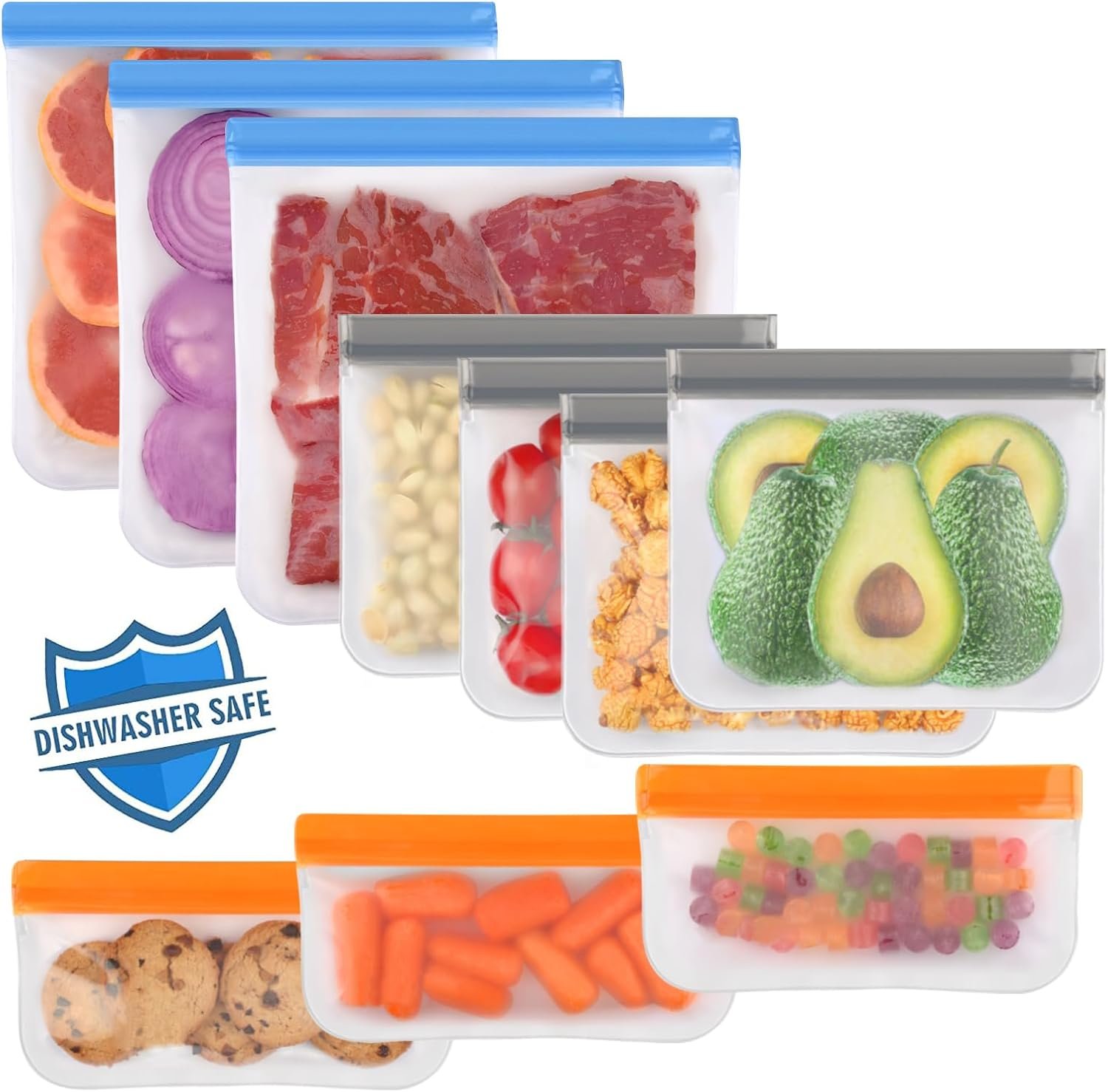
- Alibaba Cost: $2.50 per set
- Amazon Fees (FBA + Referral): $7.50
- Shipping & Other Costs: $1.80
- Competitor Average Price: $19.99
- Profit Per Unit: $8.19
- Profit Margin: 41%
Yes, there’s competition, but it’s not dominated by huge household names. You can easily stand out with unique colors, a different mix of sizes, or by bundling them with a simple cleaning brush.
2. Magnetic Phone Car Mount (Vent Clip)
Let’s face it, almost everyone uses their phone for navigation. A good car mount isn’t a want; it’s a need. This product solves a clear, everyday problem for millions of drivers. The trick is to find a supplier with a seriously strong magnet and a durable clip. Bad reviews in this niche almost always complain about poor quality.
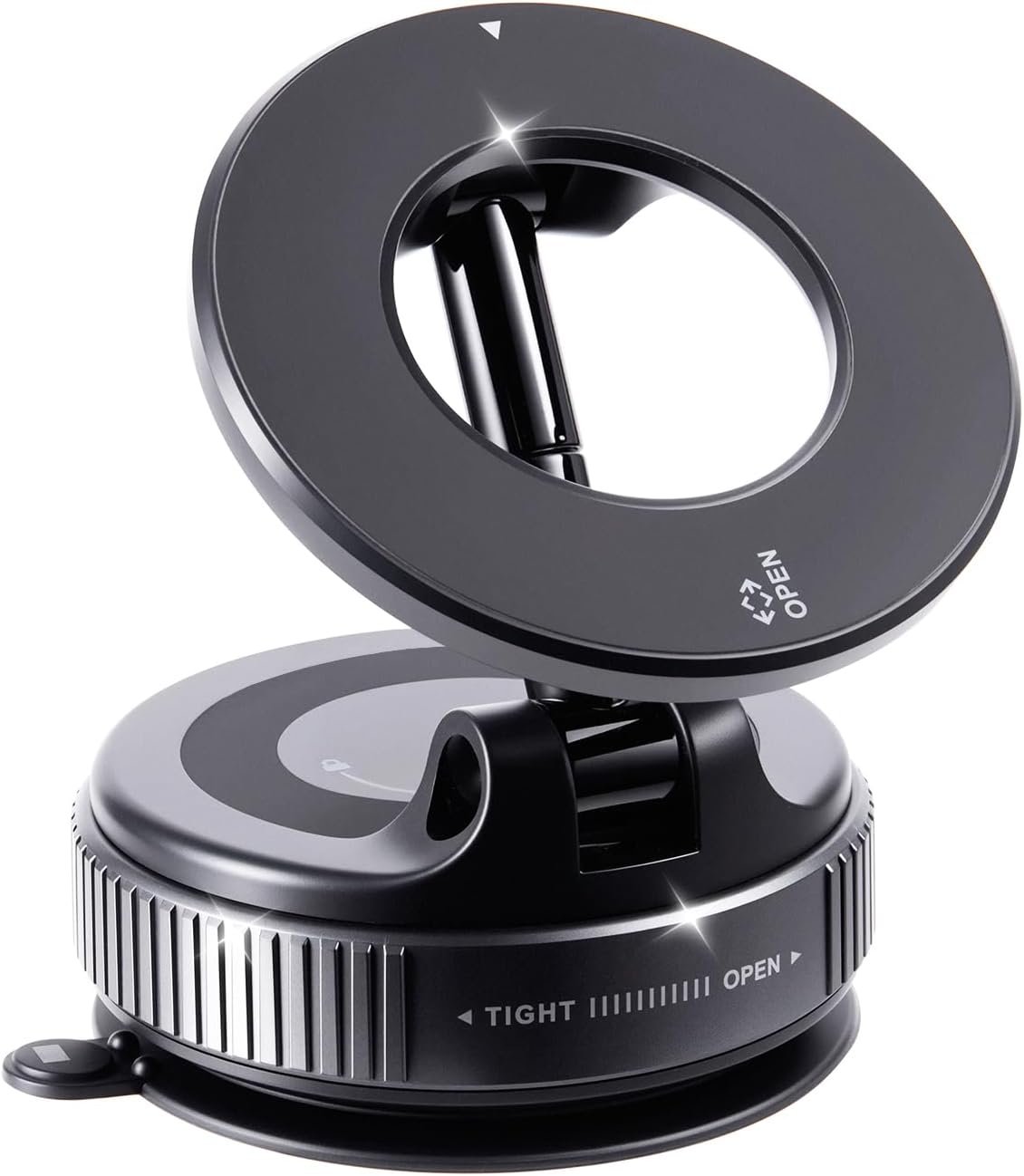
- Alibaba Cost: $2.10 per unit
- Amazon Fees (FBA + Referral): $6.20
- Shipping & Other Costs: $1.20
- Competitor Average Price: $15.99
- Profit Per Unit: $6.49
- Profit Margin: 40%
This is a high-volume category. By focusing on quality and calling it out in your main images (e.g., “Holds All Phone Sizes Securely”), you can carve out a very profitable spot for yourself.
3. Under-Cabinet LED Puck Lights (3-Pack, Remote Controlled)
The DIY home improvement wave is still rolling. These lights are a perfect solution for renters or homeowners who want a quick kitchen or closet upgrade without calling an electrician. Adding features like a remote control and dimming functions instantly adds perceived value.
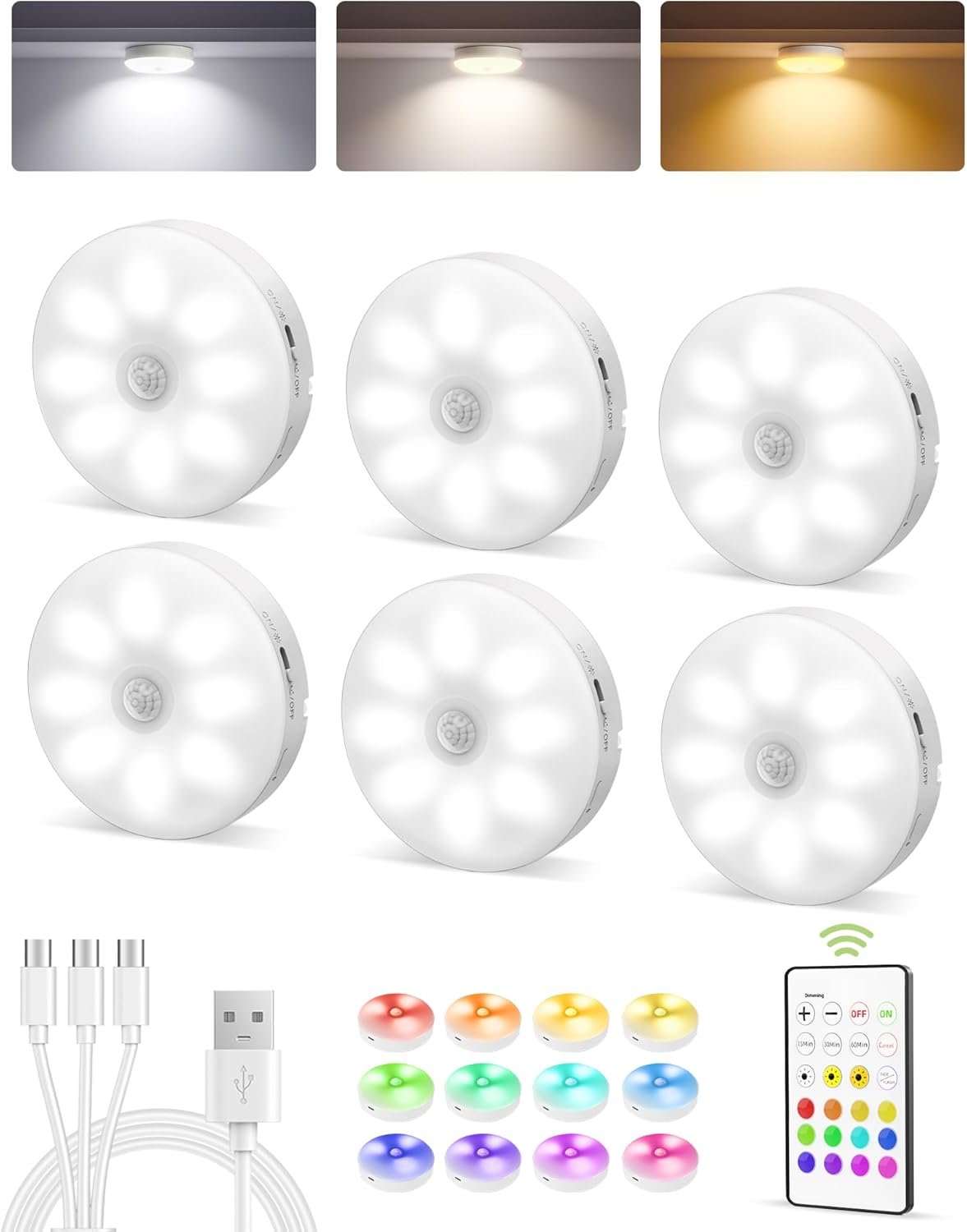
- Alibaba Cost: $5.50 per pack
- Amazon Fees (FBA + Referral): $8.50
- Shipping & Other Costs: $2.50
- Competitor Average Price: $26.99
- Profit Per Unit: $10.49
- Profit Margin: 39%
Selling these in a 3-pack is a smart move. Most customers need more than one, which pushes up your average order value and your total profit per sale.
4. Portable Pet Water Bottle with Bowl
Pet owners are some of the most loyal and motivated buyers on the planet. This gadget is a lifesaver for anyone who hikes, travels, or just takes long walks with their dog. It solves a simple problem: how to keep your pet hydrated on the go. Emphasize a leak-proof design and durability in your listing.
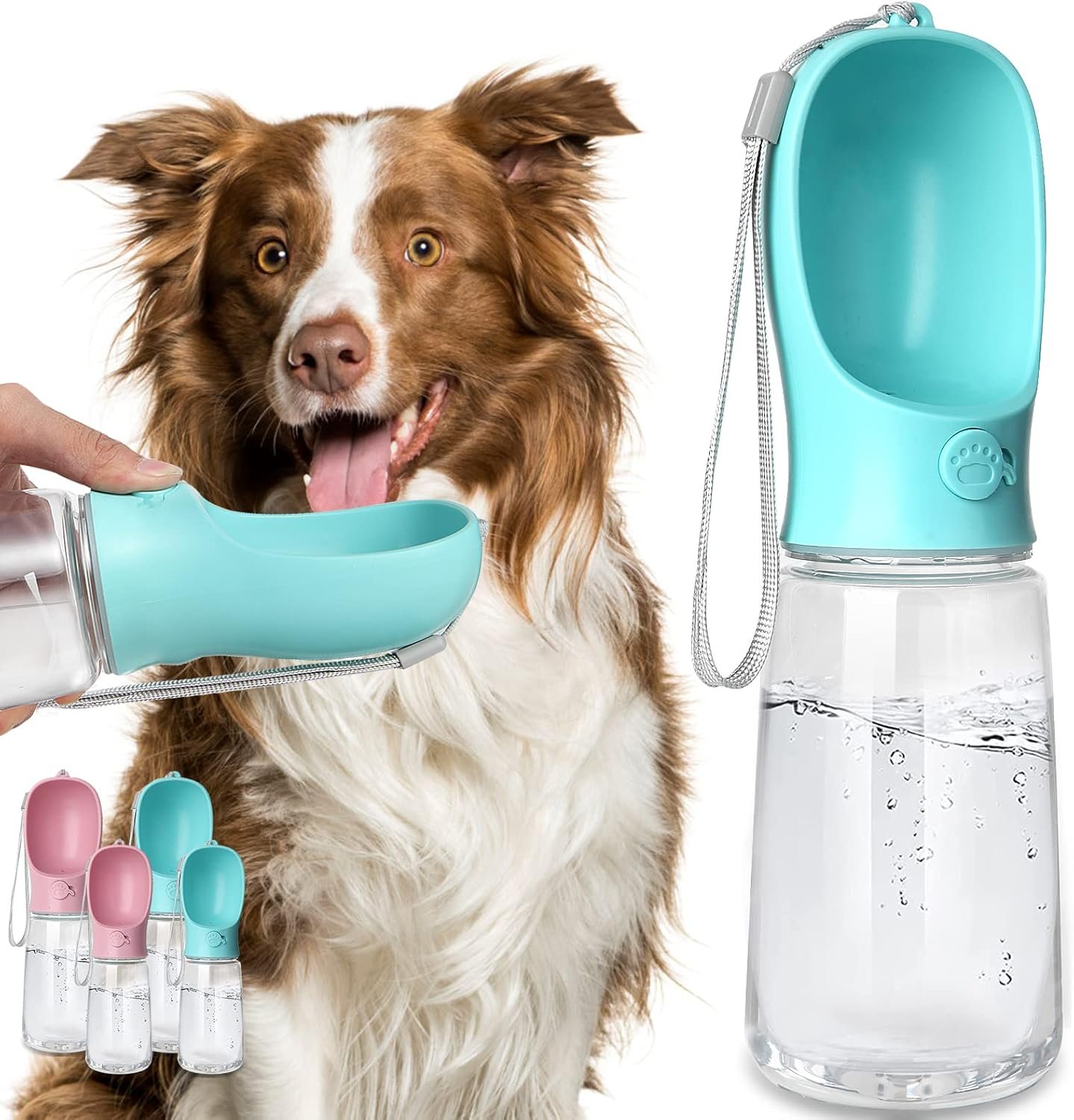
- Alibaba Cost: $3.00 per unit
- Amazon Fees (FBA + Referral): $7.00
- Shipping & Other Costs: $1.50
- Competitor Average Price: $17.99
- Profit Per Unit: $6.49
- Profit Margin: 36%
This is a classic example of a great niche within the massive Pet Supplies category. It’s specific enough to dodge the fiercest competition but has a big enough audience for steady sales.
5. Blue Light Blocking Glasses
With so many of us staring at screens all day for work and play, eye strain is a universal complaint. These glasses offer a simple, non-medical solution. The market is definitely crowded, but there’s still room to win by focusing on stylish frames and proving your lenses actually work.
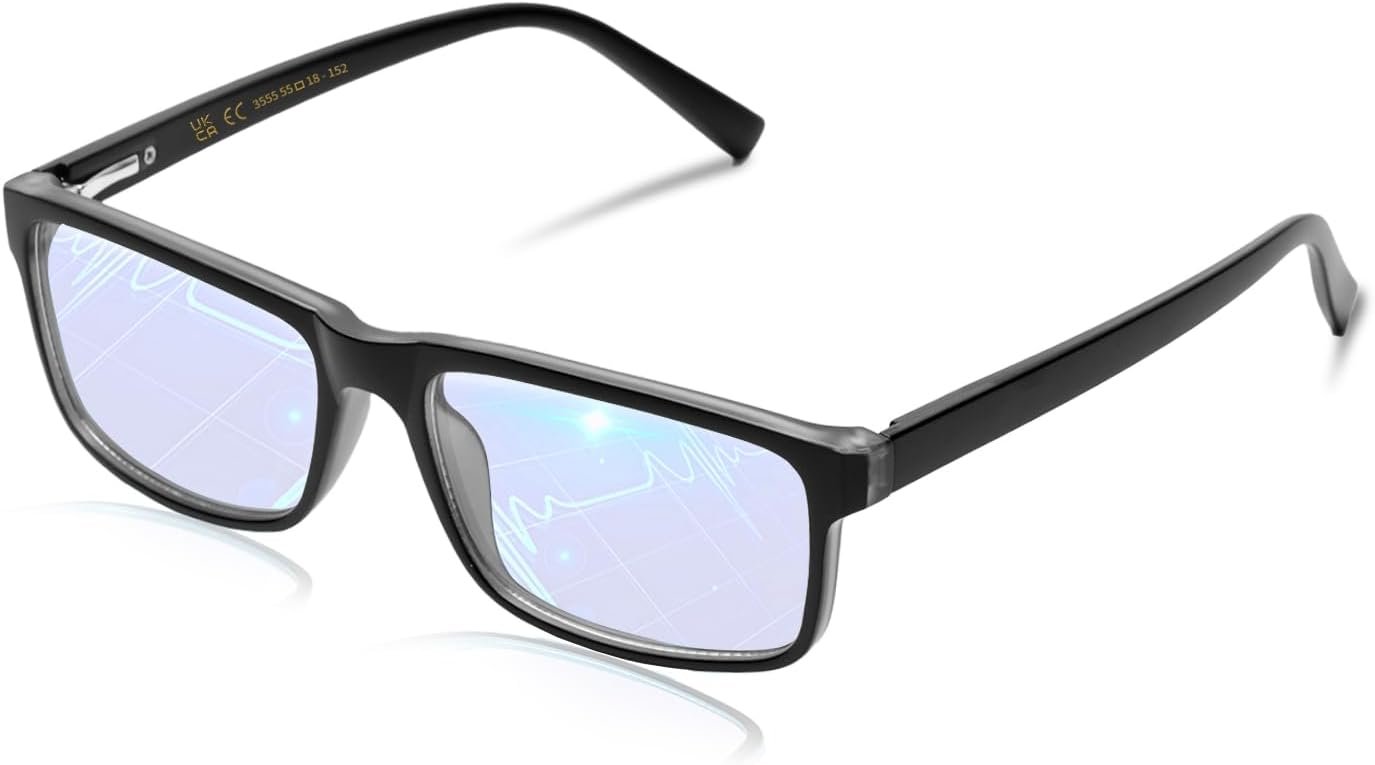
- Alibaba Cost: $1.80 per pair
- Amazon Fees (FBA + Referral): $6.00
- Shipping & Other Costs: $1.00
- Competitor Average Price: $14.99
- Profit Per Unit: $6.19
- Profit Margin: 41%
A simple way to get an edge is to offer a two-pack or bundle a single pair with a nice case and cleaning cloth. It makes your listing feel like a better deal than the competition.
6. Bamboo Bath Caddy Tray
This product is all about the self-care and home-spa trend. It turns a normal bath into a little slice of luxury. Features like a book holder, a wine glass slot, and adjustable sides are huge selling points. The bamboo material also appeals to shoppers who love that natural, aesthetic vibe.
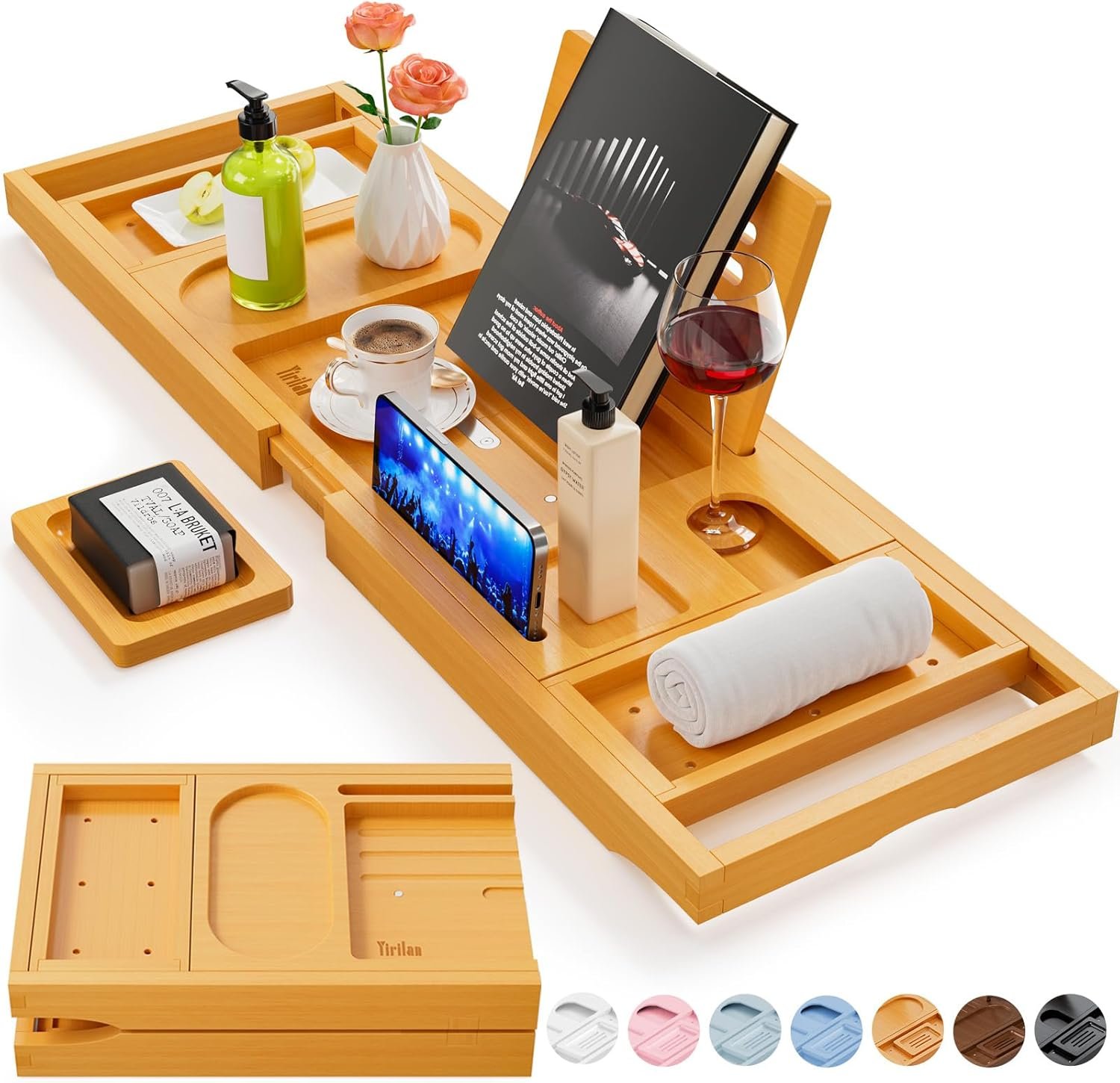
- Alibaba Cost: $8.00 per unit
- Amazon Fees (FBA + Referral): $12.00 (slightly oversized)
- Shipping & Other Costs: $4.50
- Competitor Average Price: $39.99
- Profit Per Unit: $15.49
- Profit Margin: 38%
Because this item has a higher price point, you make more cash on every single sale. It’s also a fantastic gift, so you can expect sales to jump around Christmas, Valentine’s, and Mother’s Day.
7. Collapsible Silicone Travel Coffee Cup
Here we have a product that hits three key markets: commuters, travelers, and the eco-conscious. It solves the annoying problem of bulky travel mugs by collapsing down to fit in a purse or even a pocket. It’s modern, practical, and looks great in listing photos.
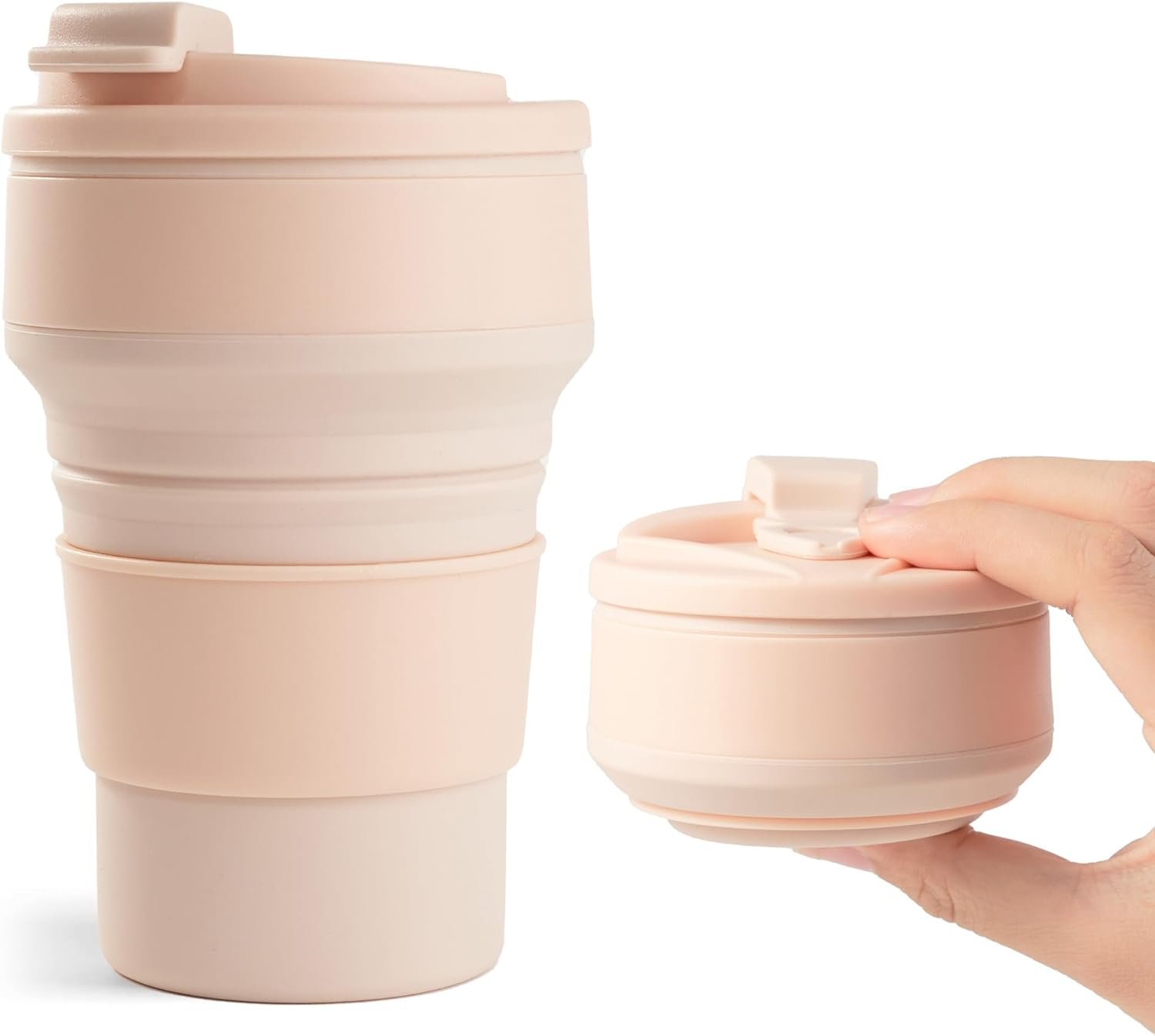
- Alibaba Cost: $2.75 per unit
- Amazon Fees (FBA + Referral): $6.50
- Shipping & Other Costs: $1.25
- Competitor Average Price: $16.99
- Profit Per Unit: $6.49
- Profit Margin: 38%
Like the food bags, this product is a win for the sustainability trend. Make sure to highlight that it’s made from BPA-free material and has a leak-proof lid to build trust with shoppers.
Let’s pause and look at the numbers together. Here’s a quick table to visualize the profit potential across these different ideas.
Profit Breakdown for 7 High Potential Amazon Products
| Product Idea | Alibaba Cost | Amazon Fees | Shipping & Other | Competitor Price | Profit Margin |
|---|---|---|---|---|---|
| Reusable Silicone Bags | $2.50 | $7.50 | $1.80 | $19.99 | 41% |
| Magnetic Car Mount | $2.10 | $6.20 | $1.20 | $15.99 | 40% |
| LED Puck Lights | $5.50 | $8.50 | $2.50 | $26.99 | 39% |
| Pet Water Bottle | $3.00 | $7.00 | $1.50 | $17.99 | 36% |
| Blue Light Glasses | $1.80 | $6.00 | $1.00 | $14.99 | 41% |
| Bamboo Bath Caddy | $8.00 | $12.00 | $4.50 | $39.99 | 38% |
| Collapsible Coffee Cup | $2.75 | $6.50 | $1.25 | $16.99 | 38% |
You don’t need to reinvent the wheel, just study the customer negative reviews and create better version that competiotrs are selling.
Each of these products solves a real problem, has steady demand, and with smart sourcing, can hit those juicy profit margins. While these are just estimates, they give you a solid blueprint for your own research.
And if this private label model isn’t for you, there are other ways to find products. You can learn more in our guide on Amazon retail arbitrage.
Why Tech and Smart Home Gadgets Keep Winning
It’s no mystery why consumer electronics and smart home gadgets are such heavy hitters on Amazon. Other categories might have their moment, but tech consistently dominates the bestseller lists because it taps into our most basic desires: convenience, security, and efficiency. This isn’t about flashy new toys; it’s about solving real problems we all deal with every day.
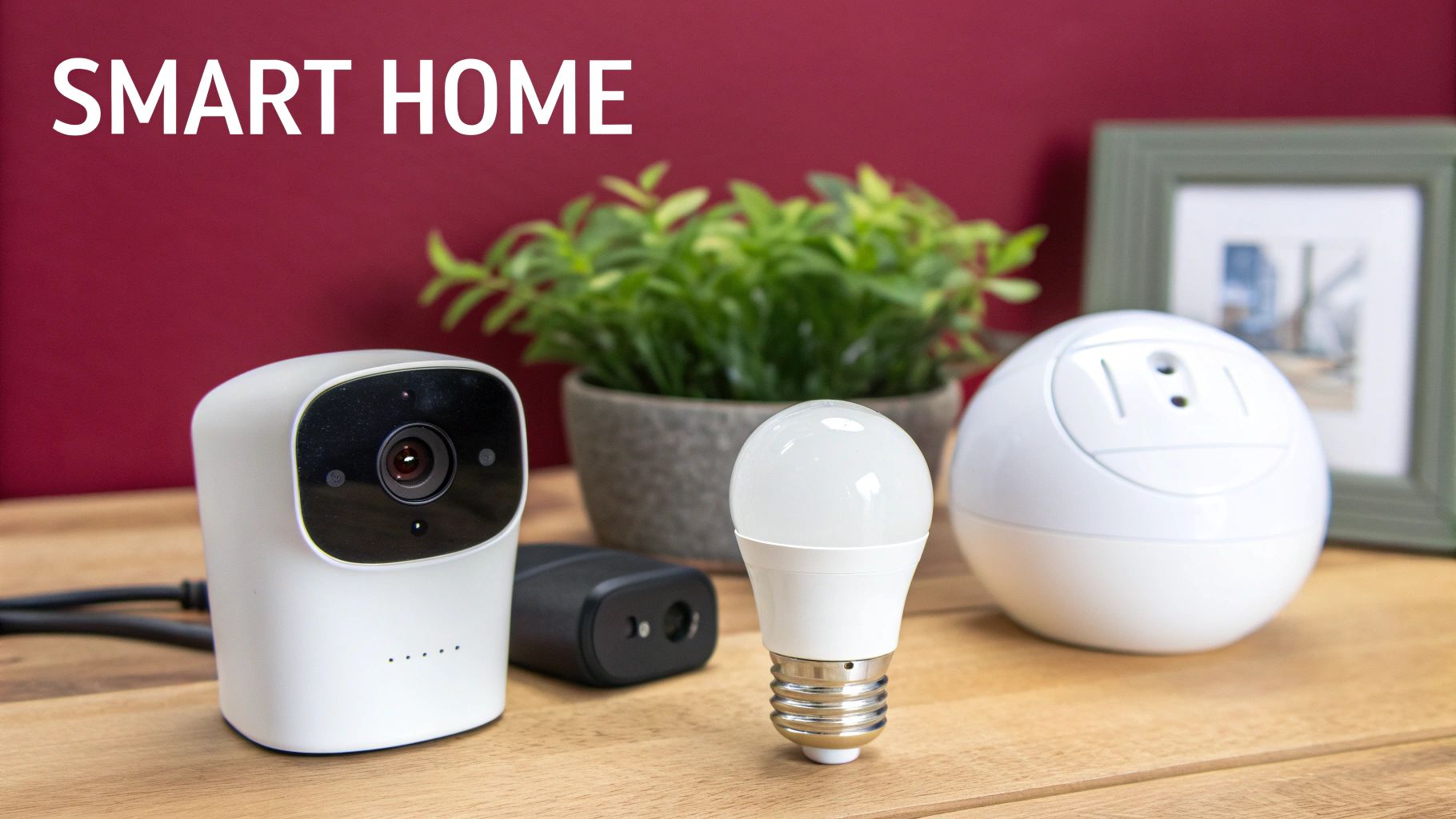
Just look at the products that own this space. Smart plugs, security cameras, and automated lighting aren’t just novelties anymore; they’re becoming standard household items. Why? Because they offer real, tangible benefits. A smart plug cuts down on your energy bill, a Ring camera gives you peace of mind, and smart bulbs can improve both your home’s vibe and its security. That connection to practical, real-world value is what fuels such steady demand.
The Power of Convenience and Automation
The explosion in home automation is what’s really driving this category’s success. We’re all busier than ever, and people are more than willing to invest in products that claw back a little bit of their time and simplify their lives. A voice-controlled smart speaker that can manage your timers, play music, and order groceries isn’t some far-off futuristic concept anymore. For millions, it’s just another daily utility.
The global smart home market is on track to blow past $300 billion by 2025, and Amazon is ground zero for where people are buying these products. This isn’t a small trend; it’s a massive consumer shift toward homes that are more connected and convenient.
This growth is all fueled by a simple truth: these devices just make life easier. The appeal of a thermostat that learns your routine or lights that pop on the moment you pull into the driveway is incredibly strong. As a seller, tapping into that deep-seated need for a seamless life is one of the most reliable ways to find profitable products.
How Sellers Can Succeed in a Competitive Space
Jumping into the tech category can feel like trying to compete with giants, but you don’t have to go head-to-head with the big brands. Success often comes down to being smarter, not bigger, by finding a unique angle and delivering an amazing customer experience.
Here are a few strategies that actually work:
- Work With Proven Suppliers: Partner with manufacturers known for consistent quality and reliability. Certified production and stable performance matter more than low pricing.
- Inspect Every Unit Before Shipping: For electronics, never rely on partial checks. Full inspections prevent defects, returns, and poor customer experiences.
- Create Unique Bundles: Instead of just selling one smart plug, what about offering a “Smart Home Starter Kit”? You could bundle two plugs, a smart bulb, and a dead-simple setup guide. It immediately adds more value and makes your listing stand out from the sea of single-item offers.
- Focus on a Niche: You don’t need to sell the most advanced smart thermostat on the market. Think smaller. Consider niches like smart garage door openers, automated pet feeders, or even smart garden sensors. These smaller ponds have less competition and are filled with highly motivated buyers looking for a specific solution.
- Offer Stellar Customer Support: Let’s face it, tech can be confusing for a lot of people. Providing dead-simple instructions, being super responsive to emails, and maybe even creating a few video tutorials can build a crazy amount of trust and lead to glowing reviews. A reputation for fantastic support is a massive competitive advantage.
At the end of the day, the tech and smart home category keeps winning because it evolves right alongside our lives. As our homes get more connected, the hunger for devices that add convenience, security, and a touch of modern magic will only keep growing. You can dig deeper into the latest trends in Amazon best sellers to stay ahead of the curve.
Using Amazon’s Sales Events for Maximum Profit
Knowing what products sell best is only half the battle. A huge part of finding success on Amazon is knowing when they sell best.
Think of major sales events like Prime Day or the holiday rush from Black Friday to Cyber Monday as goldmines. They aren’t just a chance to offload some discounted inventory; they’re massive traffic magnets that can lift your entire store.
During these peak times, shopper behavior changes completely. People aren’t just browsing; they’re on a mission, credit cards in hand, actively hunting for deals. This creates an intense, high-conversion environment where products that solve a problem or make a great gift can fly off the virtual shelves.

Capitalizing on the Surge
The numbers behind these events are staggering. Amazon’s major sales events consistently generate billions in sales, dwarfing typical shopping days.
Some of the top sellers are exactly what you’d expect: heavily discounted electronics like Apple AirPods and home essentials like premium vacuums. You can dig into the data on these top-selling items to see how powerful these events are for driving pure volume.
But you don’t need to be selling the latest gadget to win here. The real key is preparing your own inventory and ad campaigns to ride the wave.
- Work With Proven Suppliers: In tech products, quality control starts with your supplier. Choose manufacturers with proven experience, verified certifications, and consistent production standards. Never compromise reliability for lower cost.
- Inspect Every Unit: Always perform a full pre-shipment inspection, not just a sample check. Electronics require complete testing to prevent defects, returns, and negative reviews that hurt your brand.
- Stock Up Strategically: Pull your sales data from last year’s event. What were your top sellers? Make sure you have plenty of those on hand, because running out of stock during a traffic surge is one of the most painful missed opportunities on Amazon.
- Time Your Promotions: You can create your own deals, like coupons or Prime Exclusive Discounts, to run alongside the main event. This helps your product stand out to all those deal-hungry shoppers scrolling through the search results.
- Adjust Your Ad Budgets: Your daily ad spend will get used up much faster during these high-traffic periods. You’ll need to increase your PPC budgets to stay visible, but keep a close eye on your ACoS to make sure you’re still profitable.
Understanding the Halo Effect
One of the coolest things about these sales events is what’s known as the “halo effect.” This is where the massive flood of site-wide traffic ends up benefiting everyone, not just sellers offering deep discounts.
A shopper might land on Amazon looking for a cheap TV but end up buying your non-discounted yoga mat because it popped up in their search.
This means you can still see a significant lift in sales even if you don’t run a major promotion. A well-planned and perfectly executed strategy for these sales events is a key piece of a successful product launch on Amazon. By lining up your own marketing calendar with Amazon’s, you can turn these high-traffic windows into your most profitable weeks of the entire year.
Finding What Actually Works for You
So, after digging through all that data, what’s the real secret to finding a winning product on Amazon? It’s this: there is no single “best” product. The perfect item for a seller with a $20,000 budget is a world away from the right choice for someone just starting out with $3,500.
Your success won’t come from discovering one magic bullet product. It comes from building a rock-solid research framework and applying it over and over to find what works for your business, your budget, and your goals.
The Core Principles Revisited
Let’s boil it all down to the fundamentals that truly build a lasting Amazon business. These aren’t just tips; they’re the pillars you build everything on.
- Focus on Demand, Not Passion: Your passion projects are great, but your Amazon products need to solve a problem for a market that’s already spending money. Find niches with proven, high demand and competition you can realistically beat.
- Know Your Numbers: Get surgical with your profit margins. If a product can’t hit at least a 25-30% margin after every single fee, shipping cost, and ad dollar is accounted for, you have to be willing to walk away. No exceptions.
- Validate with Data: Never trust your gut alone. Use the tools at your disposal to confirm sales history, check for weird seasonal dips with Google Trends, and pick apart your competitors’ weaknesses. Data is your safety net.
The goal here isn’t a one-off win. It’s about creating a predictable, profitable system. That means starting small with a test order, getting real-world sales data, and being ready to pivot based on what the market tells you. And as you map out your strategy, understanding the crucial differences between business models like dropshipping vs. Amazon FBA will help you align your approach with your resources.
At the end of the day, building a real brand on Amazon is a marathon, not a sprint. It’s all about making a series of smart, data-backed decisions that add up over time.
Frequently Asked Questions
Got questions? You’re not alone. When you’re trying to figure out what sells best on Amazon, a few common sticking points always come up. Here are some straight-up answers to help you get moving.
What product categories should new sellers avoid?
When you’re just starting, you can save yourself a world of pain by staying away from categories loaded with risk or high barriers to entry. It’s much smarter to get your feet wet with simpler products first.
For starters, you’ll want to steer clear of gated categories like supplements or groceries. Getting into these requires special approval from Amazon, and they come with some serious liability issues if a product causes a problem.
Complex electronics are another tough nut to crack. They often have sky-high return rates because customers get frustrated trying to figure them out, which leads to a storm of negative reviews. And don’t even get me started on apparel; between the endless sizing headaches and trying to compete with established fashion giants, it’s a real battle.
Instead, start with more straightforward, durable products. Think categories like:
- Home & Kitchen
- Office Products
- Pet Supplies
How much money do I really need to start on Amazon FBA?
Look, there’s no single magic number, but if you want to give yourself a fighting chance, a realistic starting budget is somewhere between $3,500 and $5,000. It’s incredibly difficult to build any real momentum with less than that.
So, where does all that cash go? Here’s a quick look:
- First Inventory Order: $1,500 – $2,500
- Professional Product Photos: $300 – $500
- Research Software (like Helium 10): ~$100/month
- Amazon Professional Seller Fee: $39.99/month
- Initial Advertising Budget: $500 – $1,000
Trying to launch on a shoestring budget is a recipe for failure. You won’t be able to order enough inventory to stay in stock, and you won’t have the cash for the ads you need to kickstart those crucial first sales.
Is it better to sell a trendy product or an evergreen one?
If your goal is to build a real, sustainable business, evergreen products are almost always the smarter play. We’re talking about items with steady, year-round demand, like kitchen gadgets or desk organizers. They create a predictable income stream you can actually build a brand on.
Trendy products, like that gadget everyone’s talking about on TikTok, can deliver a quick cash injection. But that demand can disappear just as fast as it showed up, leaving you stuck with a garage full of inventory nobody wants.
Here’s a solid strategy: build the foundation of your business on reliable evergreen products. Once you’ve got a stable base, then you can think about dipping your toes into a trendy item if you feel confident you can ride the wave and get out before it crashes. This gives you stability with a shot at some exciting upside.
How do I know if a product idea is too competitive?
Go to Amazon and search for your main keyword. Now, look at the top 10 results. If every single listing is from a major brand like Nike or OXO and they all have 5,000+ reviews, that’s a huge red flag. You’re looking for niches where the top sellers have under 1,000 reviews, maybe some imperfect listings, or a good mix of smaller brands. Those are the battlefields where a new seller can actually win.
What is the minimum profit margin I should aim for?
I always tell people to shoot for 30% or more. But realistically, your minimum target after all costs, including your ad spend, should be around 20-25%. If you go any lower than that, you have zero room for error. An unexpected price war, a jump in shipping costs, or a bad week of advertising could completely wipe out your profit. Aim high so you have a cushion.





